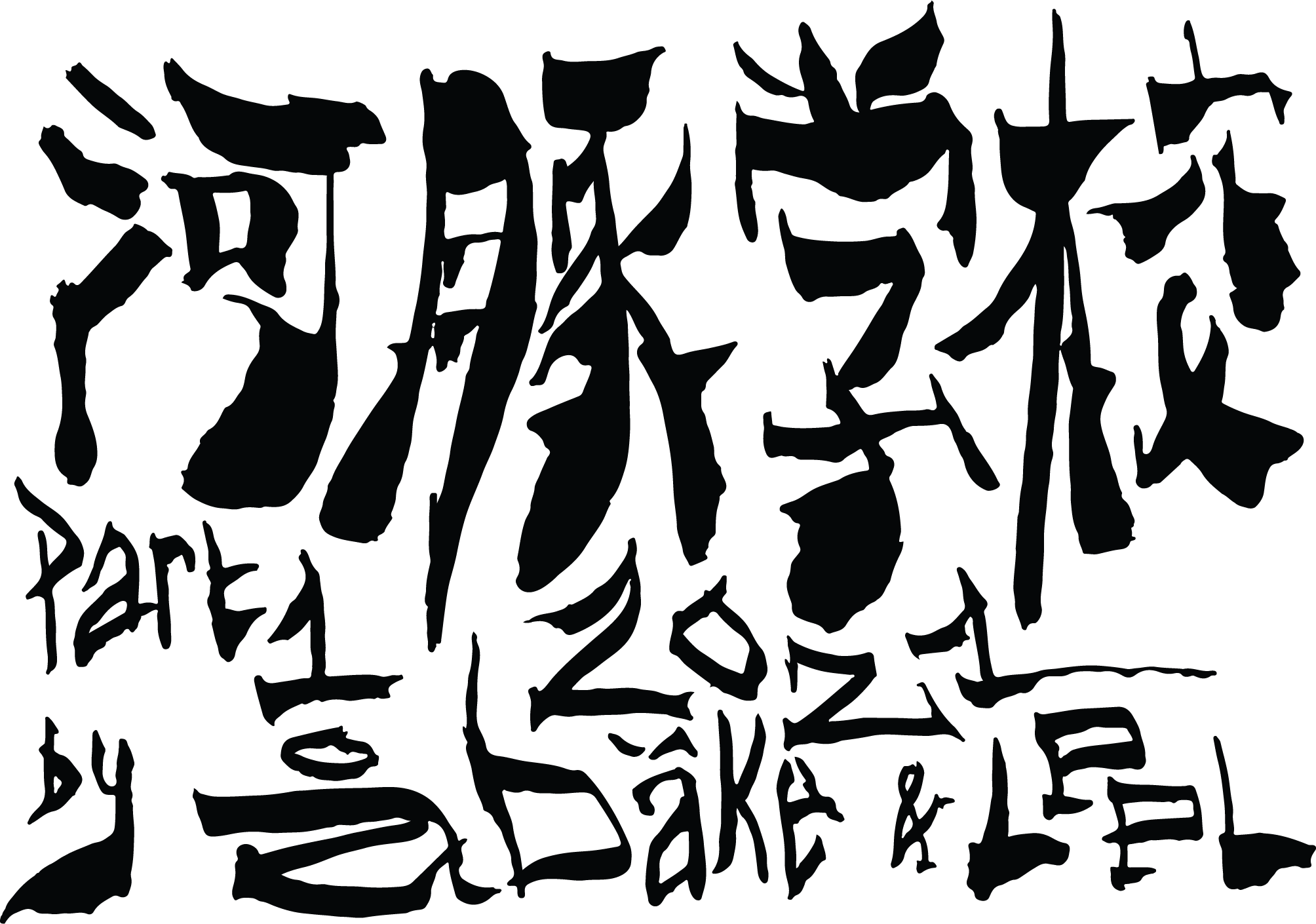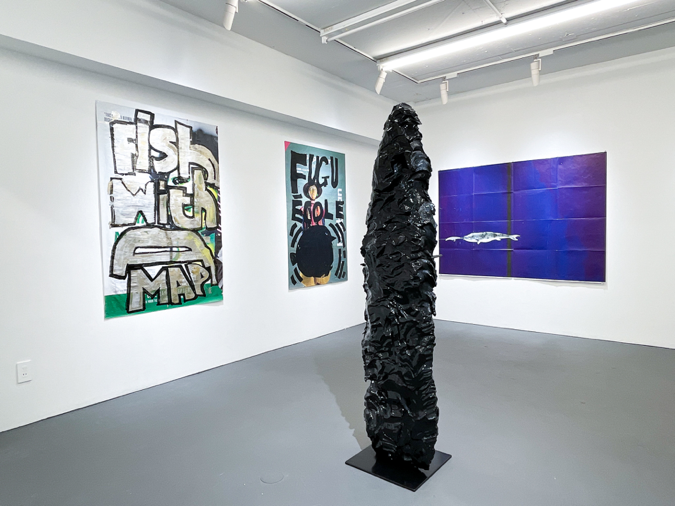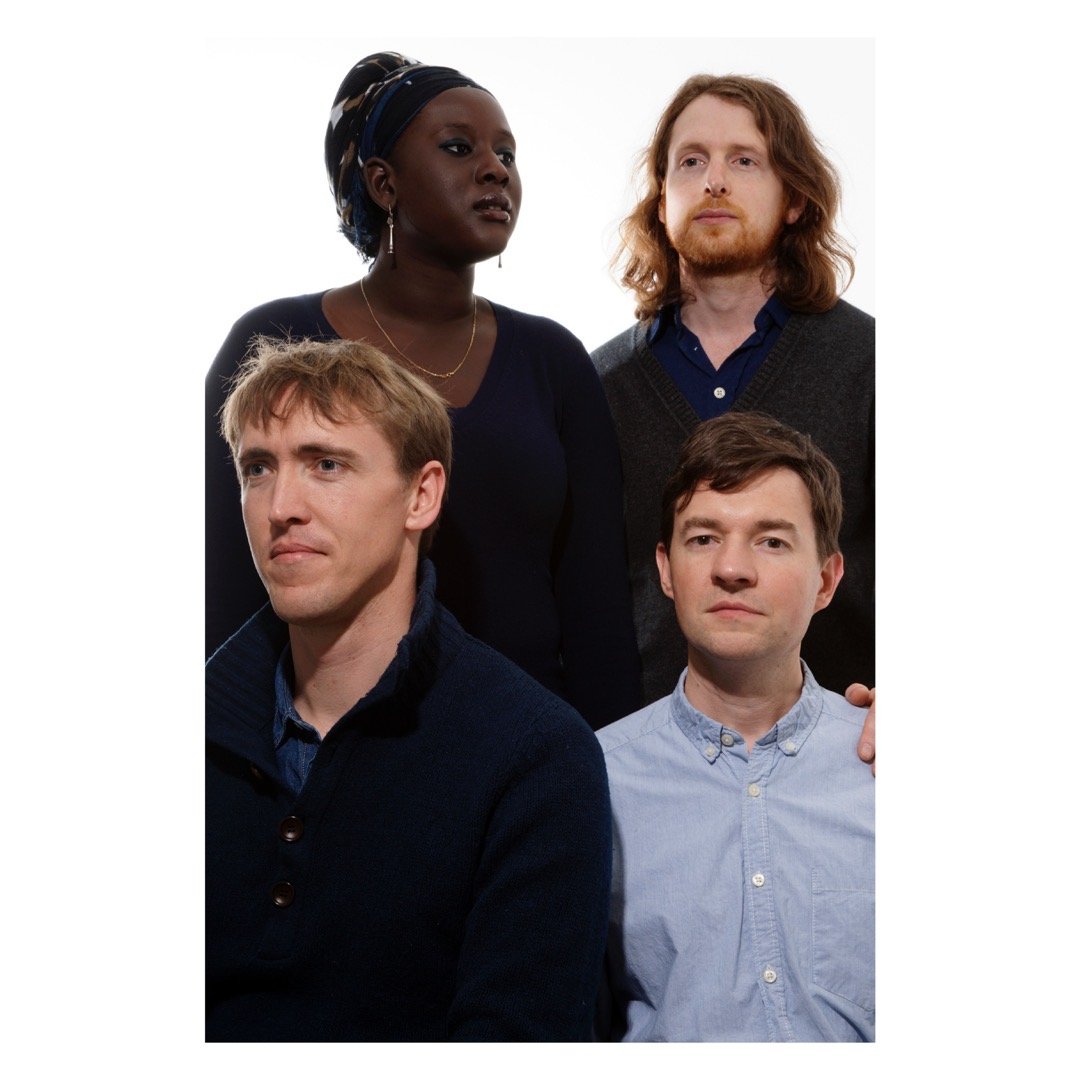åbäke & LPPL
河豚学校 Part1 2021
5 November - 4 December 2021
CLEAR GALLERY TOKYOでは、åbäke and LPPLによる、「河豚学校 part1 2021」展を開催いたします。
ロンドンを拠点とする、グラフィックデザインスタジオ åbäkeは、2018年第4回イスタンブール・デザインビエンナーレ「A School of Schools」にて、「Fugu Okul」を出展しました。このプロジェクトは、2003年にトルコ沖で謎の出現を見せたフグ(河豚)を出発点として、環境問題から、地政学、現代美術まで、さまざまな分野を探求し学ぶことを提案しています。フグを起点とした一連の経験的なリサーチを通した、実験的、共同的、参加型の「研究」は、デザイン、芸術を通した知識の成果物というだけでなく、その状況における、自己と、社会及び自然との倫理的、権力的な構成について示唆しています。
本展では、イスタンブールの街で見たグラフィティから、社会において害敵とみなされる存在=トルコで即座に外来種の烙印を押されたフグを紐付け、作家の好きなスターのポスターの上に落書きを施した作品の他、フグの剥製を用いた漆の作品、イスタンブールのガラタ橋で売られている釣り竿を保持する道具を用いた作品、作家が寄稿したテキストとのエクスチェンジとしてMax Lambとコラボレーションをした彫刻作品、日本からヨーロッパへ旅をするフグの物語をもとに、テムズ川の砂で鋳造されたHPソースとブルドックソースのボトルを、スウェーデンにいるガラス作家(Yoko Andersson Yamano)の吹きガラスと融合させた作品など展示いたします。「Fugu Okul」及び「河豚学校」は、言語や国境、政治や宗教などさまざまな要因で分断される時代に、連想と興味によって、人々と会話を深め、理解するための進歩的で、学際的なアプローチです。この機会にぜひご覧いただけましたら幸いです。
CLEAR GALLERY TOKYO is pleased to announce the exhibition "Fugu School part1 2021" by åbäke and LPPL.
London-based graphic design studio åbäke exhibited "Fugu Okul" at the 2018 4th Istanbul Design Biennale "A School of Schools".
The project takes as its starting point the mysterious appearance of the fugu (blowfish) off the coast of Turkey in 2003, and proposes to explore and learn about various fields, from environmental issues to geopolitics and contemporary art. The experimental, collaborative, and participatory "research" through a series of empirical studies using the fugu as a starting point is not only a product of knowledge through design and art, but also suggests an ethical and power configuration of the self, society, and nature in this context.
In this exhibition, åbäke connects graffiti in the city of Istanbul and fugu, which are regarded as an invasive alien species in Turkey, with what is seen as a harmful enemy in society. In addition to graffiti on posters of the artist's favorite stars, there is a lacquer work using taxidermied fugu, a work using a fishing rod holding device sold on Galata bridge in Istanbul. Other sculpture works that are created in collaboration with Max Lamb as an exchange for texts contributed by the artist, and also the one based on the story of fugu that travels from Japan to Europe, bottles of british HP Sauce and Japanese Bulldog Sauce casted with sand of Thames river attached to blown glass by Swedish glass artist Yoko Andersson Yamano.
“Fugu Okul" and "Fugu School" are progressive, interdisciplinary approaches to deepening conversations and understanding through associations and interests in an age divided by language, borders, politics, religion, and other factors.
20世紀の最初に、日本人の漁師がフグを捕らえました。もし食べれば人々を殺すことが可能な毒を持つ、それゆえに有名な、危険な魚です。彼は彼の娘の為に、この魚を乾燥させてフグ提灯(ちょうちん)を作りました。そして、数ヶ月後、そのフグ提灯は間もなくヨーロッパに帰るフランスのイエズス会僧士に売られました。ところが、彼はイスタンブールに派遣されることになり、彼はそのフグ提灯を持参し、トルコ首都のより貧しい人達を教育する為に設立された自然歴史博物館に寄贈され、展示品となりました。
フグはアジア地域に存在し、そこでは多くの国で食べられています。人を殺すことができる魚を料理し提供されるのは、それが美味と考えられる日本で、特別許可を受けたレストランだけがそれを提供することが出来ます。1972年に、イスタンブール市の市長は日本のフグの中心都市ともいえる下関市と姉妹都市の協定を結びました。2003年に、最初の生きたフグはトルコの南の海岸(地中海)で発見されました。この侵略的な種類は、地中海には1859年に建設されたスエズ運河を泳いで渡りやってこなければなりませんでした。それは2000年初頭頃よりの地球温暖化の為に 充分に温かくなったスエズ運河だからこそ出来たのです。
2019年より、FUGU OKUL財団は、経済、科学、文学と並んで、フグの研究という新しいカリキュラムオプションの実施をすべての中学校に提案するようになります。
In the beginning of the 20th century a Japanese fisherman caught a fugu, a blowfish notorious for a toxin that can kill people if eaten. He dried and kept the fish for his daughter as a lantern. A few months ago it was sold to a foreign traveller who went back to Europe where he sold the fish to a Jesuit brother in France. As he was assigned to Istanbul he brought the fugu and it was added to the natural history museum established to educate the poorer population of the turkish capital.
The fugu lives in Asia where it is eaten in many countries. The rituals of preparing a fish that can kill humans is especially controlled in Japan where it is considered a delicacy and only licensed restaurants can prepare and serve it. In 1972 The mayor of Istanbul twinned the city with Shimonoseki in Japan, the capital of the fugu. In 2003, the first live fugu were spotted in the souther cost of Turkey. This invasive specie had come to the mediterranean sea by swimming across the Suez Canal, built in 1859 but only warm enough because of global warming in the early 2000.
From 2019 FUGU OKUL is proposing all secondary schools the implementation of a new curriculum option, alongside economics, scientific and literature: the study of the fugu.
FUGU OKUL
is a school
is an exhibition
of painted posters, sculptures and a film
「ギリシャとトルコの漁師が2003年に地中海で初めて河豚(フグ)を発見した。
彼らは東南アジアに生息しているフグが、実は人を死に至らせるほどの猛毒を持つ生き物として有名だったのを知らなかった」という記事を読んだことがあります。フグは人間の利己的な2つの要因(スエズ運河の建設と地球温暖化)のせいで地中海に現れたのです。
そう思い始めてから自分でも、もう少しこれらの要因について探求してみようという気持ちが出てきました。例えば14〜15歳向けのカリキュラムで(一般的には科学、文学、経済、などありますが)もしも河豚学があったらどうだろうかと。各学問のジャンルとかではなく、仮に一つの対象物(フグ)が学びの導入であったら、一つの生物からどんな問題にも関連させて学びの対象を広げていけることでしょう。例えば、授業で医者を呼んだらフグの持つ毒「テトロドトキシン」を癌患者の治療に使うといった医学的な話をしてくれるし、人類学者なら死に至るほどの危険な毒を持つ魚を食べる人々の文化について教えてくれる。またスエズ運河の建設について歴史学者と建築家が一緒になって、なぜこの大きな水路をつなぐ導管を作ったのかの説明を聞くこともできる。Fugu Okul(河豚学校)の教育方針では、それぞれ学生が自分の興味があるものを自由に見つけ、そこから学問的に探求していくことができるものかどうかが重要になってきます。
プロセスよって作品は変化していくものです。以前訪れたイスタンブールにあるイエズス系フランス学校では約100年前のフグの標本を自分たちイエズス会の人々の学習教材として使っていました。トルコのアナトリア半島にあるキャンプ場に行った時は、10年以上フグを調理しているシェフが漁師らと同様に、フグが侵略的外来種と呼ばれていることに対して異論を持っているようでした。その後、深夜または早朝のイスタンブールの街を散歩していると、グラフィティの存在と外来種として煙たがられるものについて、自分の中でその2つがリンクしました。イスタンブールの街で見たグラフィティーは知名度の高いニューヨークのグラフィティアーティストのものもあれば、イスタンブールの地元の人が描いたものなど様々です。社会的にはグラフィティ自体は寄生虫のような存在ですが、それを排除することは不可能に近いため共存していくしかありません。だからグラフィティは今回の展示のインスタレーションの一部になったのです。
私自身がイスタンブールで観察してきた事すべてをこの展示に反映しました。また別の作品は、ガラタ橋で実際に売られている釣り竿を固定しておく道具で、主に廃材を使って作られていて、これは釣り人なら全員持っているものです。特にこのガラタ橋において一番よく考えられたデザインだと思います。教育のためのポスターはグラフィティ(落書き)のようにみえます。これらは私が現代のロールモデルとして捉えている人物たち(コートニー・バーネット、ジャネール・モネイ、ビヨンセ、ヴィヴィアン・ウエストウッド、クリスティン・アンド・ザ・クイーン、ハイムなど)の盗まれたポスターです。彼らの顔の上に落書きするのは、少し気が引けましたが。それらの内、当時7歳になる私の娘(FUGU OKULの第2番目の生徒)と一緒に作ったポスターもあります。ちなみにFUGU OKULの1人目の生徒は私です。
最後に、イスタンブールとフグで有名な下関が1972年から姉妹都市であるという偶然は、あまりに驚きでした。だからこそ、次の展覧会は日本でなくてはならないのです。
2018年「第4回 Istanbul Design Biennial A School of Schools」で発表された「FUGU OKUL」展より
FUGU OKUL
is a school
is an exhibition
of painted posters, sculptures and a film
I had read about this part of the mediterranean sea where the fugu had been spotted for the first time in 2003 by greek and turkish fishermen who had no idea this fish was famous for its toxin that can kill humans and usually live on the other side of the planet in South East Asia. It came because of two major anthropocentric “activities”, namely the construction of the Suez Canal and global warming.
I had the feeling that I could educate myself if I was digging a little bit about this so I started imagining a curriculum for, say 14-15 year olds who, in many parts of the world are given a thematic orientation between, science and litterature or finance etc. What if they could choose with the fugu as a start? Instead of themes, it would start from a single object, which in this case is also a living organism to expand on pretty much anything else.
A doctor could come and speak of a possible use of the tetrodotoxin as a relief for cancer patient, an anthropologue could speak of the tradition of eating the fish despite its danger, an architect could speak of the Suez canal alongside a historian to explain why we made this conduit linking major waterways etc. Fugu Okul is a principle, the teaching would be necessarily be based on the abilities of participants to hyperlinks interests and creative digressions. This work is shifting because of the process. I went to see a jesuit French school in Istanbul where they have 100 year old specimen of the fugu which the jesuits then had exchanged in order to educate people.
I went to Anatolia and met a camp resort manager and his chef who have been cooking the fugu for more than ten years as well as a fisherman who clearly disagreed with the fact this fish is called invasive. Later, while walking around Istanbul either late or very early in the morning I could clearly see a link with the presence of Graffiti, some from famous New Yorkers and others as local writers, a parasitical presence which one can only live with because to fight it is just destructive. So graffiti became a part of the installation. All the observations I made in Istanbul made its way in the work.
One display hangs from a design structure which is a fishing rod holding device sold on Galata bridge. It is so perfect every fisherman has one, it is made with scrap wood but is the most efficient design on this specific bridge. In my display it is a hanging device. Equally the educational posters look like graffiti and they are on stolen posters of people I’d consider role models in the mainstream popular culture such as Courtney Barnett, Janelle Monae, Beyoncé, Vivienne Westwood, Christine and the Queen or Haim. It was hard to deface them but they are there also. Some of the posters I made with my daughter who is seven and the second person to enroll with FUGU OKUL, the first one being me.
The final observation is that Istanbul was twinned with Shimonoseki in 1972. The coincidence that Shimonoseki is the capital of Fugu in Japan is just extraordinary. This is why the next place for the exhibition must be in Japan.
About åbäke
åbäke (アバケ / オバケ) は、ロイヤル・カレッジ・オブ・アートで出会ったPatrick Lacey(イギリス)、Benjamin Reichen(フランス)、Kajsa Ståhl(スウェーデン)、Maki Suzuki(フランス)によって、イギリス・ロンドンで設立された、グラフィックデザイン集団です。
活動初期より現代美術の世界でも活躍しており、グラフィックがどのようにして文化的な伝達形態をとるかという問題を提起し、デザインの社会的側面と、コラボレーションがプロジェクトにもたらす力をテーマに、独立した、領域を横断する参加型のプロジェクトを作成しています。
åbäkeの活動は、建築(Sexymachinery)と料理(Social Pasta, Trattoria)、出版社(Dent-de-Léone)、スパイエージェント(Affice Suzuki )、衣料品とレコードのレーベル(Kitsuné)など多岐にわたり、アーティスト(Ryan Gander,Francis Upritchard,Per Hüttner,Johanna Billing,Fritz Haegなど),機関/組織(NMNM,Design Museum,Victoria and Albert Museum,Museum of Finnish Architecture,Serpentine Galley,CASCOなど),ミュージシャン(The Cardigans,Daft Punkなど),デザイナー(Maison Martin Margiela,Hussein Chalayan,Peter Jensen,Martino Gamperなど)などと世界各国でコラボレーションを行っています。彼らはまた、場所にまつわるの文化的な物語やアートのメカニズムについてを考察し、物語性のあるオブジェや文章も制作しています。
åbäke is a graphic design collective founded in London, UK by Patrick Lacey (UK), Benjamin Reichen (France), Kajsa Ståhl (Sweden), and Maki Suzuki (France), who met at the Royal College of Art. Since its early days, åbäke has been active in the contemporary art world, creating independent, cross-disciplinary and participatory projects that raise the question of how graphics become a form of cultural communication, and address the social aspects of design and the power that collaboration can bring to a project.
åbäke's work has ranged in many fields, such as architecture (Sexymachinery), cuisine (Social Pasta, Trattoria), publishing (Dent-de-Léone), spy agency (Affice Suzuki), and clothing and record label (Kitsuné). Moreover, they have done many collaboration with artists (Ryan Gander, Francis Upritchard, Per Hüttner, Johanna Billing, Fritz Haeg, etc.), institutions/organizations (NMNM, Design Museum, Victoria and Albert Museum, Museum of Finnish Architecture, Serpentine Gallery, CASCO, etc.), musicians (The Cardigans, Daft Punk, etc.), designers (Maison Martin Margiela, Hussein Chalayan, Peter Jensen, Martino Gamper, etc.) around the world.
They also reflect on the cultural stories of place and the mechanisms of art and create storytelling objects and texts.




















